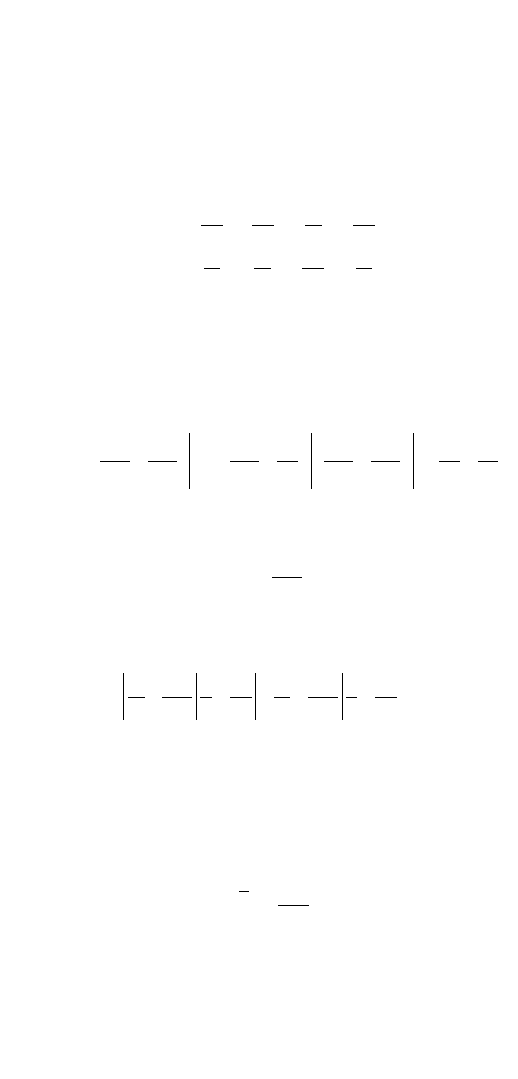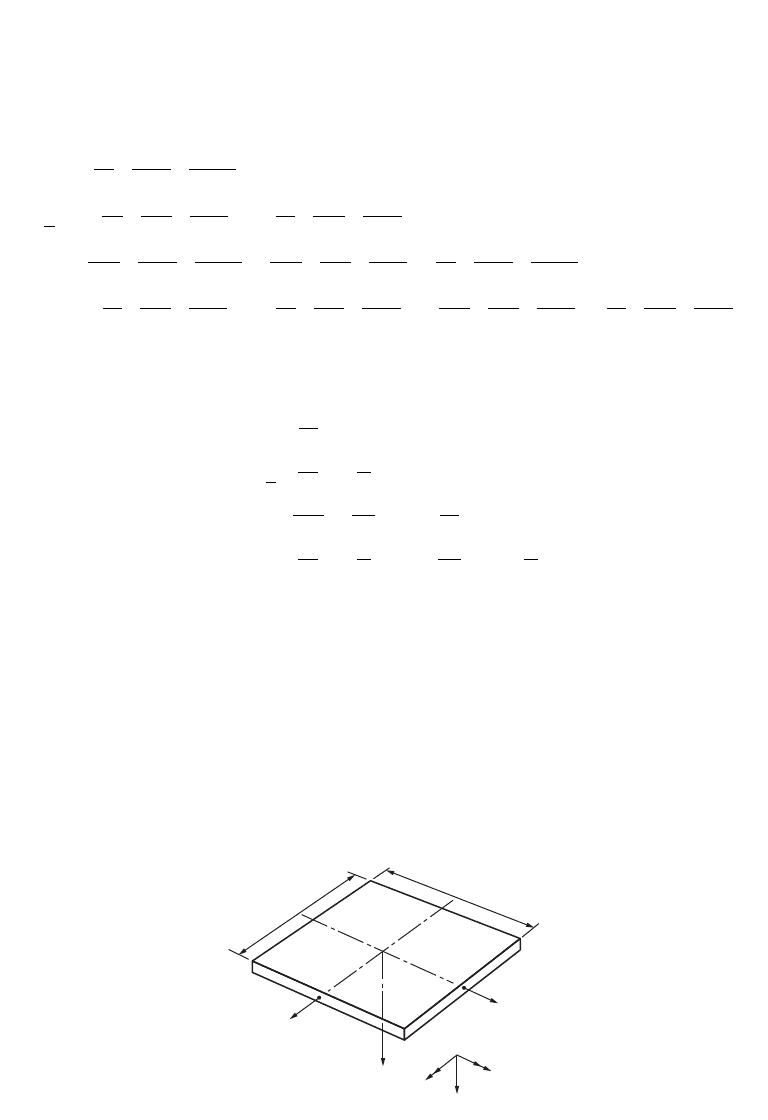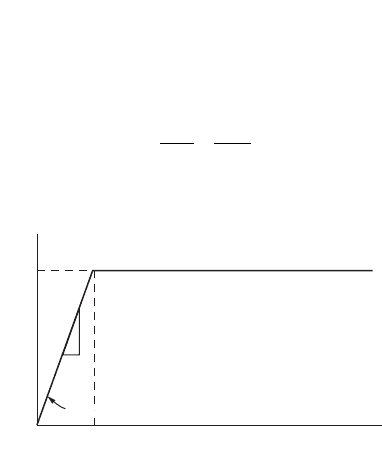Wai-Fah Chen.The Civil Engineering Handbook
Подождите немного. Документ загружается.


Theory and Analysis of Structures 47-101
The total potential energy of the element is
V = U + W
or
(47.168)
Using the principle of minimum total potential energy, we obtain
or
(47.169)
where
(47.170a)
and
(47.170b)
Plates Subjected to In-Plane Forces
The simplest element available in two-dimensional stress analysis is the triangular element. The stiffness
and consistent load matrices of such an element will now be obtained by applying the equation derived
in the previous section.
Consider the triangular element shown in Fig. 47.90a. There are two degrees of freedom per node and
a total of six degrees of freedom for the entire element. We can write
u = A
1
+ A
2
x + A
3
y
and
v = A
4
+ A
5
x + A
6
y
expressed as
(47.171)
or
(47.172)
VD BEBdvDDQD Lqda
TT
v
TTT
a
=
{}
[][][]
Ê
Ë
Á
Á
ˆ
¯
˜
˜
{}
-
{}{}
-
{}
[]
{}
ÚÚ
1
2
*****
BEBdvD Q L qda
T
v
T
a
[][][]
Ê
Ë
Á
Á
ˆ
¯
˜
˜
{}
=
{}
+
[]
{}
ÚÚ
**
KD F
[]
{}
=
{}
**
KBEBdv
T
v
[]
=
[][][]
Ú
FQ Lqda
T
a
**
{}
=
{}
+
[]
{}
Ú
f
u
v
xy
xy
A
A
A
A
A
A
{}
=
Ï
Ì
Ó
¸
˝
˛
=
È
Î
Í
˘
˚
˙
Ï
Ì
Ô
Ô
Ô
Ô
Ó
Ô
Ô
Ô
Ô
¸
˝
Ô
Ô
Ô
Ô
˛
Ô
Ô
Ô
Ô
1000
0001
1
2
3
4
5
6
fPA
{}
=
[]
{}
© 2003 by CRC Press LLC

47-102 The Civil Engineering Handbook, Second Edition
Once the displacement function is available, the strains for a plane problem are obtained from
and
Matrix [B], relating the strains to the nodal displacement {D
*
}, is thus given as
(47.173)
b
i
, c
i
, etc. are constants related to the nodal coordinates only. The strains inside the element must all be
constant and hence the name of the element.
For derivation of strain matrix, only isotropic material is considered. The plane stress and plane strain
cases can be combined to give the following elasticity matrix, which relates the stresses to the strains:
(47.174)
where
and
and for both cases,
and
–
E is the modulus of elasticity.
The stiffness matrix can now be formulated according to Eq. (47.170a)
where D is the area of the element.
The stiffness matrix is given by Eq. (47.10.37a) as
ee
xy
=
∂
∂
=
∂
∂
u
x
v
y
xy
u
y
v
x
g
=
∂
∂
∂
∂
B
bbb
cc c
cbcbc b
ijm
ij m
ijjjmm
[]
=
È
Î
Í
Í
Í
˘
˚
˙
˙
˙
1
2
00 0
00 0
D
E
CCC
CC C
C
[]
=
È
Î
Í
Í
Í
˘
˚
˙
˙
˙
112
12 1
12
0
0
00
CE C
1
2
2
1=-
()
=nn and for plane stress
C
E
C
12
1
112 1
=
-
()
+
()
-
()
=
-
()
n
nn
n
n
and for plane stress
CC C
12 1 2
12=-
()
EB
CCC
CC C
C
bbb
cc c
cbcbc b
ijm
ij m
iijjmm
[][]
=
È
Î
Í
Í
Í
˘
˚
˙
˙
˙
È
Î
Í
Í
Í
˘
˚
˙
˙
˙
1
2
0
0
00
00 0
000
112
12 1
12
D
KBEBdv
T
v
[]
=
[][][]
Ú
© 2003 by CRC Press LLC

Theory and Analysis of Structures 47-103
The stiffness matrix has been worked out algebraically to be
Beam Element
The stiffness matrix for a beam element with two degrees of freedom (one deflection and one rotation)
can be derived in the same manner as for other finite elements using Eq. (47.170a).
The beam element has two nodes, one at each end, and two degrees of freedom at each node, giving
it a total of four degrees of freedom. The displacement function can be assumed as
i.e.,
or
With the origin of the x and y axis at the left-hand end of the beam, we can express the nodal
displacement parameters as
K
h
Cb
Cc
CCbc Cc
CbcCb Symmetrical
Cbb CCbc Cb
Ccc Cbc Cc
CCbc Ccc CC bc Cc
Cb
i
i
ii i
ii i
ij ji j
ij ij j
ij ij jj j
j
[]
=
+
++
++ +
+
4
1
2
12
2
12 1
2
12 12
2
112 1
2
12 12 12
2
12 1 12 1
2
12
D
ccCbbCbc Cb
Cbb CCb c Cbb CCb c Cb
Ccc Cbc Ccc Cbc Cc
CCbc Ccc CC bc Ccc
iij jj j
im mi jm mj m
im im jm jm m
im im jm j
++ +
+++ + +
112 12
2
1121 12 1
2
12 12 12 12 12
2
12 1 12 1 mmmmm
mi i m mj j m mm m
CCb c Cc
Cbc Cbb Cbc Cbb Cbc Cb
12 1
2
12 12 12 12 12 12
2
+++ + + +
È
Î
Í
Í
Í
Í
Í
Í
Í
Í
Í
Í
Í
Í
Í
Í
Í
Í
Í
Í
˘
˚
˙
˙
˙
˙
˙
˙
˙
˙
˙
˙
˙
˙
˙
˙
˙
˙
˙
˙
fwA AxAx Ax== + + +
12 3
2
4
3
fxxx
A
A
A
A
=
[]
Ï
Ì
Ô
Ô
Ó
Ô
Ô
¸
˝
Ô
Ô
˛
Ô
Ô
1
23
1
2
3
4
fPA=
[]
{}
Dw AA A A
D
dw
dx
AA A
Dw AAlAlAl
D
dw
dx
A
x
x
x
x
1
0
12 3
2
4
3
2
0
23 4
2
3
1
12 3
2
4
3
4
1
2
00 0
2030
*
*
*
*
=
()
=+
()
+
()
+
()
=
Ê
Ë
Á
ˆ
¯
˜
=+
()
+
()
=
()
=+
()
+
()
+
()
=
Ê
Ë
Á
ˆ
¯
˜
=
=
=
=
=
++
()
+
()
23
34
2
Al Al
© 2003 by CRC Press LLC

47-104 The Civil Engineering Handbook, Second Edition
or
where
and
Using Eq. (47.177), we obtain
(47.175)
or
(47.176)
Neglecting shear deformation
Substituting Eq. (47.191) into Eq. (47.176) and the result into Eq. (47.192)
or
The moment–curvature relationship is given by
where
–
E is the modulus of elasticity,
or
We know that {s} = [E]{e}, so we have for the beam element
[E] =
–
EI
DCA*
{}
=
[]
{}
ACD
{}
=
[]
{}
-1
*
C
IIII
IIII
[]
=
-- -
-
È
Î
Í
Í
Í
Í
Í
Í
˘
˚
˙
˙
˙
˙
˙
˙
-1
22
3232
1000
0100
323 1
21 21
LPC
[]
=
[][]
-1
C
x
I
x
I
x
x
I
x
I
x
I
x
I
x
I
x
I
[]
=- +
Ê
Ë
Á
ˆ
¯
˜
-+
Ê
Ë
Á
ˆ
¯
˜
-
Ê
Ë
Á
ˆ
¯
˜
-+
Ê
Ë
Á
ˆ
¯
˜
È
Î
Í
Í
˘
˚
˙
˙
-1
2
2
3
3
23
2
2
2
3
3
23
2
1
32 2 32
e
{}
=-
dy
dx
2
2
e
{}
=- --+ -
È
Î
Í
˘
˚
˙
{}
61246 61226
23 223 2
I
x
II
x
II
x
II
x
I
D*
e
{}
=
[]
{}
BD*
MEI
d
y
d
x
2
2
=-
Ê
Ë
Á
ˆ
¯
˜
e
{}
=
[]
{}
BD*
© 2003 by CRC Press LLC

Theory and Analysis of Structures 47-105
The stiffness matrix can now be obtained from Eq. (47.170a) written in the form
with the integration over the length of the beam. Substituting for [B] and [E], we obtain
or
(47.178)
Plate Element
For the rectangular bending element shown in Fig. 47.91 with three degrees of freedom (one deflection
and two rotations) at each node, the displacement function can be chosen as a polynomial with 12
undetermined constants:
(47.179)
FIGURE 47.91 Rectangular bending element.
KBdBdx
T
[]
=
[][][]
Ú
0
1
kEI
xx
symmetrical
xx xx
xx xx xx
xx x
[]
=
-+
-+ -+
-
+-
-
+- - +
-+ -
36 144 144
24 84 72 16 48 36
36 144 144 24 84 72 36 144 144
12 60 72 8 36
45
2
6
34
2
523
2
4
45
2
634
2
545
2
6
34
2
523
ll l
ll l ll l
ll l lll ll l
ll l ll
++
-
+- -+
È
Î
Í
Í
Í
Í
Í
Í
Í
Í
Í
˘
˚
˙
˙
˙
˙
˙
˙
˙
˙
˙
Ú
36 12 60 72 4 24 36
2
434
2
523
2
4
1
xxxxx
dx
o
lllllll
KEI
symmetrical
[]
=
--
-
È
Î
Í
Í
Í
Í
Í
Í
Í
Í
˘
˚
˙
˙
˙
˙
˙
˙
˙
˙
12
64
12 6 12
62 6 4
3
2
32 3
22
l
ll
ll l
ll l l
fwAAxAyAxAxyAy Ax
Axy Axy A y Axy Axy
{}
== + + + + + +
++++ +
12 3 4
2
56
2
7
3
8
2
9
2
10
3
11
3
12
3
i
c
k
x
b
j
y
z
l
w,F
z
θ
x
,F
x
θ
y
,F
y
© 2003 by CRC Press LLC

47-106 The Civil Engineering Handbook, Second Edition
or
The displacement parameter vector is defined as
where
As in the case of beams, it is possible to derive from Eq. (47.179) a system of 12 equations relating
{D
*
} to constants {A}. The last equation
(47.180)
The curvatures of the plate element at any point (x, y) are given by
By differentiating Eq. (47.180), we obtain
(47.181)
or
(47.182)
where
(47.183)
and
(47.184)
fPA
{}
=
{}{ }
Dw w w w
ixiyi jxj yj k xk yk x y
*,,,,,,,,
{}
=
{}
qq qq q q qq
lll
xy
w
y
and
w
x
qq
=
∂
∂
=-
∂
∂
wLLLLD
ijk
=
[][][][]
È
Î
Í
˘
˚
˙
{}
l
*
e
∂
∂
∂
∂
∂
∂∂
{}
=
-
-
Ï
Ì
Ô
Ô
Ô
Ó
Ô
Ô
Ô
¸
˝
Ô
Ô
Ô
˛
Ô
Ô
Ô
2
2
2
2
2
2
w
x
w
y
w
xy
e
{}
=
[][][][]
È
Î
Í
˘
˚
˙
{}
BBB B D
ijkl
*
e
{}
=
[]
{}
=
Â
BD
r
r
rijkl
*
,, ,
B
x
L
y
L
xy
L
r
r
r
r
[]
=
-
[]
------
-
[]
------
[]
È
Î
Í
Í
Í
Í
Í
Í
Í
Í
Í
˘
˚
˙
˙
˙
˙
˙
˙
˙
˙
˙
∂
∂
∂
∂
∂
∂∂
2
2
2
2
2
2
Dw
r
rxryr
*,,
{}
=
{}
qq
© 2003 by CRC Press LLC

Theory and Analysis of Structures 47-107
For an isotropic slab, the moment–curvature relationship is given by
(47.185)
(47.186)
and
(47.187)
For orthotropic plates with the principal directions of orthotropy coinciding with the x and y axes,
no additional difficulty is experienced. In this case we have
(47.188)
where D
x
, D
1
, D
y
, and D
xy
are the orthotropic constants used by Timoshenko and Woinowsky-Krieger
(1959), and
(47.189)
where E
x
, E
y
, n
x
, n
y
, and G are the orthotropic material constants and h is the plate thickness.
Unlike the strain matrix for the plane stress triangle (see Eq. (47.173)), the stress and strain in the
present element vary with x and y. In general we calculate the stresses (moments) at the four corners.
These can be expressed in terms of the nodal displacements by Eq. (47.164), which, for an isotropic
element, take the form
s
{}
=
{}
MMM
xyxy
EN
[]
=
-
È
Î
Í
Í
Í
Í
˘
˚
˙
˙
˙
˙
10
10
00
1
2
n
n
n
N
E
12 1
2
=
-
()
h
3
n
E
DD
DD
D
x
y
xy
[]
=
È
Î
Í
Í
Í
˘
˚
˙
˙
˙
1
1
0
0
00
D
Eh
D
Eh
D
Eh Eh
D
Gh
x
x
xy
y
y
xy
xy
xy
yx
xy
xy
=
-
()
=
-
()
=
-
()
=
-
()
=
¸
˝
Ô
Ô
Ô
Ô
Ô
˛
Ô
Ô
Ô
Ô
Ô
3
3
1
33
3
12 1
12 1
12 1 12 1
12
nn
nn
n
nn
n
nn
s
s
s
s
un n n
un n n
nn
{}
{}
{}
{}
Ï
Ì
Ô
Ô
Ô
Ó
Ô
Ô
Ô
¸
˝
Ô
Ô
Ô
˛
Ô
Ô
Ô
=
+-- - -
+-- --
-- --
- -
- -
i
j
k
r
N
cb
ppc b p c p b
pp c b p c p p
66 4 4 6 2 0 6 0 2 0 0 0
66 4 4 6 2 0 6 0 2 0 0 0
11
1 1
1 1
()()bbc c b
pc ppcb p b
pc ppcb p b
() () () ()() ()
(
11 0111 01 00
6206644000602
6206644 0006 02
1
1 1
1 1
-- ---- --
-- +-- - -
-- +-- - -
--
- -
- -
nn nnn n
nn un
un n n
nnnnnn nn
un n n
nun
nn
)()()()() ()()
()(
01 1 1 1 0 0 1 1 0 0
6020006644620
6020006644620
11
1 1
1 1
----- ---
-+-
-+-
-- --
- -
- -
cb b
pb ppcbpc
pb ppcbpc
))() ()()()()()
()
bbcc
pbpcppcb
pbpcppcb
01 0 0 1 1 1 1 01
0006 026206644
0006 02 6206644
10
1 1
1 1
------ --
---+-
---+-
--
- -
- -
nnnnnn
nn un
nn un
n 001 1 0 1 01 1 1 1() () () () ()()()
*
*
*
*
--- - - -- ---
È
Î
Í
Í
Í
Í
Í
Í
Í
Í
Í
Í
Í
Í
Í
Í
Í
Í
Í
Í
˘
˚
˙
˙
˙
˙
˙
˙
˙
˙
˙
˙
˙
˙
˙
˙
˙
˙
˙
˙
{}
{}
{}
{}
Ï
Ì
Ô
Ô
Ô
Ó
Ô
Ô
Ô
¸
˝
nn n n nnnbcbc
D
D
D
D
i
j
k
r
ÔÔ
Ô
Ô
˛
Ô
Ô
Ô
S
(47.190)
© 2003 by CRC Press LLC

47-108 The Civil Engineering Handbook, Second Edition
The stiffness matrix corresponding to the 12 nodal coordinates can be calculated by
(47.191)
For an isotropic element, this gives
(47.192)
where
(47.193)
(47.194)
and [K]
–
is given by the matrix shown in Eq. (47.195).
KBEBdxdy
T
cb
cb
[]
=
[][][]
--
ÚÚ
22
22
KTkT*
N
15cb
[]
=
[]
[]
[]
T
T Submatrices not
T shown are
T zero
T
s
s
s
s
[]
=
[]
[]
[]
[]
È
Î
Í
Í
Í
Í
Í
˘
˚
˙
˙
˙
˙
˙
Tb
c
s
[]
=
È
Î
Í
Í
Í
˘
˚
˙
˙
˙
100
00
00
K
pp
pp
p
p
pp p pp
[]
=
+
-+
---
+
+
-
+
---
-+
(
+
)
-
-
+
-
+-
-=
-
-+
+
+
-+
---
-
-
-
--
60 60
12 42
30 12
3
20 4
4
30 12
3
15
20 4
4
60
12 42
30 3
3
15 12
3
60 60
12 42
30
22
22
2
2
22 2 22
n
nn
n
n
n
n
nn
n
symmetrical
30p
-2
ppp
p
p
pp
p
p
ppp p
22
2
2
22
2
2
222 2
3
3
10
1
0
30 12
3
20 4
4
15 12
3
0
10 4
4
30 12
3
15
20 4
4
60 30
12 42
15 12
3
30 3
-
+
+
-
-+
(
+
)
-
+
---
-+
+
+
-
-+
(
+
)
-
+
---
-+
+-
-
-
-
--
-
-
---
nn
n
n
nn
n
n
n
n
n
nn
n
nn
n
nn nn nn
n
+
--
-+
+
-
+
-
+
-+
---
-
-
+
-
-
+
-
+
+
+
-
+
---
-+
----
-
-
3
30 30
12 42
15 3
3
15 3
3
60 60
12 42
15 12
3
10 4
4
0
15 3
3
5
1
0
30 12
3
20 4
4
30 3
222 2 22
22 22 22
2
ppp p pp
pp pp pp
p
--
+
-
--
+
-
+
+
+
-
+
---
-+-
-+
+
--
+
+
-
-+
+-
+
-+
+
-- -- -
-
--
-
-
3
0
10
3
15 3
3
0
5
1
30 12
3
15
20 4
4
30 30
12 42
3
15 3
3
15 3
3
60 30
12 42
3
15 12
22 22 2
22
22
22
2
pp pp p
pp
pp
pp
p
nn nn
n
n
n
nn
n
n
33
30 3
3
30 60
12 42
3
30 3
3
15 12
3
60 60
12 42
15 3
3
5
1
0
15 12
3
10 4
4
0
30 3
3
10
1
0
2
22
22 22
22 22 22
p
pp
pp pp
pp pp pp
-
-
-- -
-- --
-
+
-
+-
+
-+
-
-
-
+
-+
---
-
-
-
+
-+
+
+
-
+
+
+
-
n
n
nn
n
nn nn nn
--+
(
+
)
-
+
---
--
-
-
+
-+
-
+
-
-
-
+
-
+
+
-
-
+
È
Î
Í
Í
Í
Í
Í
Í
Í
Í
Í
Í
Í
Í
--- -----
30 12
3
20 4
4
50 3
3
0
5
1
30 3
3
0
10
1
15 12
3
0
10 4
4
30 12
3
15
20 4
4
2
2
222 22222
p
p
ppp ppppp
n
n
nnn nnnn
n
n
ÍÍ
Í
Í
Í
Í
Í
Í
Í
Í
Í
Í
Í
Í
Í
Í
Í
Í
Í
Í
Í
Í
Í
Í
Í
Í
Í
Í
Í
Í
Í
Í
Í
Í
Í
˘
˚
˙
˙
˙
˙
˙
˙
˙
˙
˙
˙
˙
˙
˙
˙
˙
˙
˙
˙
˙
˙
˙
˙
˙
˙
˙
˙
˙
˙
˙
˙
˙
˙
˙
˙
˙
˙
˙
˙
˙
˙
˙
˙
˙
˙
˙
˙
S
(47.195)
© 2003 by CRC Press LLC

Theory and Analysis of Structures 47-109
If the element is subjected to a uniform load in the z direction of intensity q, the consistent load vector
becomes
(47.196)
where {Q
*
q
} is 12 forces corresponding to the nodal displacement parameters. Evaluating the integrals in
this equation gives
(47.197)
More details on the finite element method can be found in Desai and Abel (1972) and Ghali and
Neville (1978).
47.11 Inelastic Analysis
An Overall View
Inelastic analyses can be generalized into two main approaches. The first approach is known as plastic
hinge analysis. This analysis assumes that structural elements remain elastic except at critical regions
where plastic hinges are allowed to form. The second approach is known as spread of plasticity analysis.
This analysis follows explicitly the gradual spread of yielding throughout the structure. Material yielding
in the member is modeled by discretization of members into several line elements and subdivision of
the cross sections into many “fibers.” Although the spread of plasticity analysis can predict accurately the
inelastic response of the structure, the plastic hinge analysis is considered to be computationally more
efficient and less expensive to execute.
If the geometric nonlinear effect is not considered, the plastic hinge analysis predicts the maximum
load of the structure corresponding to the formation of a plastic collapse mechanism (Chen and Sohal,
Qq Ldxdy
q
T
cb
cb
*
[]
=
[]
--
ÚÚ
22
22
Q qcb
b
c
b
c
b
c
b
c
q
*
/
/
/
/
/
/
/
/
/
/
/
/
{}
=
-
----
-
-
----
----
-
Ï
Ì
Ô
Ô
Ô
Ô
Ô
Ô
Ô
Ô
Ô
Ô
Ô
Ô
Ô
Ó
Ô
Ô
Ô
Ô
Ô
Ô
Ô
Ô
Ô
Ô
Ô
Ô
Ô
¸
˝
Ô
Ô
Ô
Ô
Ô
Ô
Ô
Ô
Ô
Ô
Ô
Ô
Ô
˛
Ô
Ô
Ô
Ô
Ô
Ô
Ô
Ô
Ô
Ô
Ô
Ô
Ô
14
24
24
14
24
24
14
24
24
14
24
24
© 2003 by CRC Press LLC

47-110 The Civil Engineering Handbook, Second Edition
1995). First-order plastic analysis is finding considerable application in continuous beams and low-rise
building frames where members are loaded primarily in flexure. For tall building frames and frames with
slender columns subjected to side sway, the interaction between yielding and instability may lead to
collapse prior to the formation of a plastic mechanism (SSRC, 1988). If an incremental analysis is carried
out based on the updated deformed geometry of the structure, the analysis is termed second order. The
need for a second-order analysis of steel frames is increasing in view of the modern codes and standards
that give explicit permission for the engineer to compute load effects from a direct second-order analysis.
This section presents the virtual work principle to explain the fundamental theorems of plastic hinge
analysis. Simple and approximate techniques of practical plastic analysis methods are then introduced.
The concept of hinge-by-hinge analysis is presented. The more advanced topics, such as second-order
elastic-plastic hinge, refined plastic hinge analysis, and spread of plasticity analysis, are covered in the
Stability of Structures section.
Ductility
Plastic analysis is strictly applicable for materials that can undergo large deformation without fracture.
Steel is one such material, with an idealized stress–strain curve, as shown in Fig. 47.92. When steel is
subjected to tensile force, it will elongate elastically until the yield stress is reached. This is followed by
an increase in strain without much increase in stress. Fracture will occur at very large deformation. This
material idealization is generally known as elastic-perfectly plastic behavior. For a compact section, the
attainment of initial yielding does not result in failure of a section. The compact section will have reserved
plastic strength that depends on the shape of the cross-section. The capability of the material to deform
under a constant load without decrease in strength is the ductility characteristic of the material.
Redistribution of Forces
The benefit of using a ductile material can be demonstrated from an example of a three-bar system,
shown in Fig. 47.93. From the equilibrium condition of the system,
(47.198)
Assuming the elastic stress–strain law, the displacement and force relationship of the bars may be written
as:
(47.199)
FIGURE 47.92 Idealized stress–strain curve.
2
12
TT P+=
d= =
TL
AE
TL
AE
11 2 2
Perfectly plastic
Elastic
Strain
Stress
1
E
σ
y
ε
y
© 2003 by CRC Press LLC
